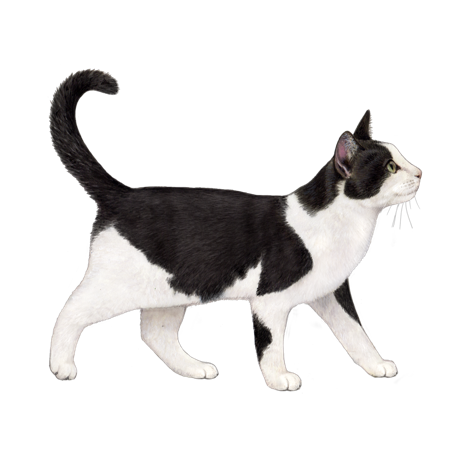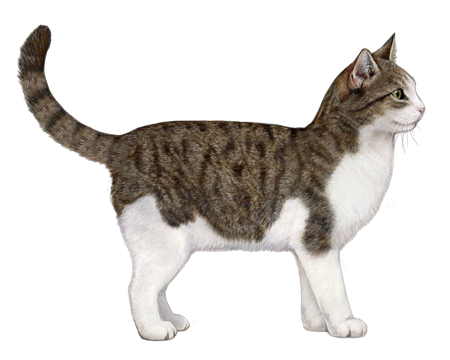
LaPerm
LaPerms are one of several curly-coated cat breeds. Active and people-oriented with a gentle, affectionate nature, they're happy to run around or relax on the couch—as long as their favorite humans are beside them.
Interested in discovering if your cat is a LaPerm?
Check out Wisdom Panel's DNA test.
LaPerm Traits
General Appearance
The LaPerm is a medium-sized, curly-coated cat with medium-boning and long legs. They have well-balanced, muscular bodies, alert expressions, and seem to walk tall on their feet.
Coat and Colouring
LaPerms can be longhaired or shorthaired. Shorthairs have light, springy coats that stand away from the body, bottlebrush tails, and curly or wavy hair. On the other hand, longhairs have semi-long hair with an airy texture, a plumed tail, and curls that give them a shaggier, unkempt look. Both types have kinked eyebrows and curled whiskers. And they come in all coat colors and patterns.
Distinctive Physical Traits
The LaPerm's key features include a wedge-shaped head with gentle contours, medium-to-large slightly flared and cupped ears, and large, expressive almond-shaped eyes.
LaPerm Temperament
LaPerms are gentle, affectionate cats that excel at both playing and snuggling. They have a patient nature and get along well with other pets and kids, making them an excellent addition to most families.
This active, curious breed wants to participate in all household activities. They follow their humans around and keep them entertained with their antics. As natural hunters, they enjoy stalking mouse toys and playing games of fetch. But when it's time to relax, they love to flop down in a lap to watch TV or nap. When cuddling with a LaPerm, expect gentle pats on the face—one of the many ways they show affection.
LaPerm History
The LaPerm's story is a classic case of "one of these things is not like the others." In 1982, a barn cat in Oregon gave birth to a litter of six kittens. Five of them appeared normal. But one was bald with a tabby pattern emblazoned in her skin. After several weeks, she started to grow a soft, curly tabby coat. The kitten's owner, Linda, aptly named her Curly.
Curly eventually had a litter of her own. All five kittens were born bald, only to develop wavy coats like their mother. Linda found these cats odd but accepted them as they were and didn't give their unusual coats much thought. But as more wavy-haired cats resulted from random-bred litters over the years, Linda started to wonder if she had something special on her hands (and in her barn).
After entering six of her cats at a cat show, Linda consulted with experts in the cat fancy. They concluded that the curly gene was dominant and carried by both male and female cats. Linda named the breed LaPerm (they did originate in the 1980s, after all) and worked with others to develop a breeding program.
In 2008, the CFA granted Championship status to the LaPerm.
LaPerm Care
Nutrition
LaPerms need a high-quality diet formulated for their current life stage (e.g., kitten, adult, senior).
To keep your cat at a healthy weight, measure out meals and reduce portions if necessary. And don't forget to account for treats—especially if giving human food as rewards. Just one ounce of cheese can account for half of an average-sized cat's daily calories. As a guideline, treats should make up no more than 10% of your pet's caloric intake.
Lastly, all cats need access to fresh, clean water around the clock.
Grooming
LaPerms don't typically shed much, and their coats aren't prone to mats or tangles. So, light combing with a metal comb should be sufficient to remove any loose fur and keep their curls intact. After bathing your LaPerm, dry them with a towel instead of a blowdryer to prevent frizzing. And if you want to give their curls some added bounce, spraying their dry coat with a fine mist of water will do the trick.
Most cats' nails require monthly trimming to prevent them from getting too long. Long nails are more likely to snag on something and become torn or damaged. They can even grow into your cat's paw pads, leading to pain or infection. In addition to clipping, providing a scratching post will allow your cat to do some nail maintenance themselves (thanks to their instinct to scratch).
No grooming routine is complete without a little dental hygiene. To support your LaPerm's overall health, brush their teeth daily and schedule visits with your veterinarian for professional dental cleanings and exams.
Health
Roughly one out of every three cats in the United States is overweight or obese. And those extra pounds can contribute to other health risks—such as arthritis, diabetes, and heart problems. Your veterinarian is the best resource for tips on managing your cat's weight.
LaPerm Genetic Health Conditions
-
Pyruvate Kinase Deficiency
Pyruvate Kinase (PK) Deficiency is a disorder that causes anemia due to the breakdown of red blood cells.
With more than 45 health tests, Wisdom Panel™ Complete for Cats screens for these and other important genetic conditions—allowing you to better plan for your cat's lifelong care.
Breed Group
Western
The largest of breed groups, the Western Group is mainly comprised of cats developed in Europe and the Americas. Due to the complexity of feline genetic diversity, however, cat breeds from other regions may also be found associated with this group.
Resources
https://tica.org/breeds/browse-all-breeds?view=article&id=850:laperm-breed&catid=79
https://cfa.org/wp-content/uploads/2019/06/laperm-standard.pdf
https://www.lapermcats.com/LPSAdescription.html
https://www.banfield.com/state-of-pet-health/obesity
Reviewed 23 February 2021 by Laura Inman, DVM


























